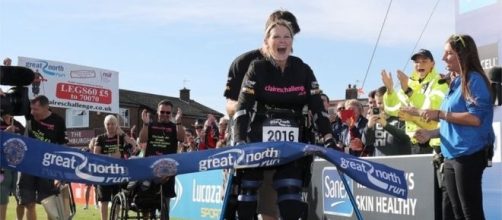In a remarkable feat, Claire Lomas who hails from Leicestershire in England successfully completed the Great North Run. The annual race is the biggest half-marathon in Europe.
To complete such a run when 16 weeks pregnant is no mean feat; to do so when paralyzed is something very special. Claire Lomas managed this using a bionic suit manufactured by robotics company ReWalk Robotics. The suit meets the accepted definition of ‘bionics’ where biological and electronics are harnessed together.
Slow but steady
Progress was slow but steady and Claire completed the 21 kilometer course in 5 days, with regular rest stops (the main race was won by Olympic champion Mo Farah.) In all Claire covered about three miles per day.
The bionic suit is designed to allow the use to lift their legs. The suit is also equipped with motion sensors fitted on the upper body, hips and feet; this array of locations gives the wearer full control of movement. The system is powered by a backpack battery.
Claire, aged 36, was paralyzed following a fall from a horse in 2007, breaking her neck and damaging her back. She had enjoyed a successful career as an event rider.
While Claire mastered the suit effectively, many hours of training were required in order to gain the basics of movement. To assist with stability crutches were used to keep Claire steady throughout her feat of endurance. She also had the support of her husband.
An inspiration for further development
On completing the run, Claire told BBC News that she hoped her achievement would inspire further developments in bionics.
Innovations in surgery and the use of bionics continues to develop with new success reported each month. While the Technology is becoming more established, the patient recovery programs are more hit and miss.
In related bionics news, one recent success, however, involves a patient of Dr. Colleen Goodwin. Goodwin has worked out a managed program to enable people, fitted with artificial prosthetics to regain movement. According to Times-Georgian, Dr. Goodwin has successfully helped a patient use an artificial hand after it was damaged from a machine accident at work.

